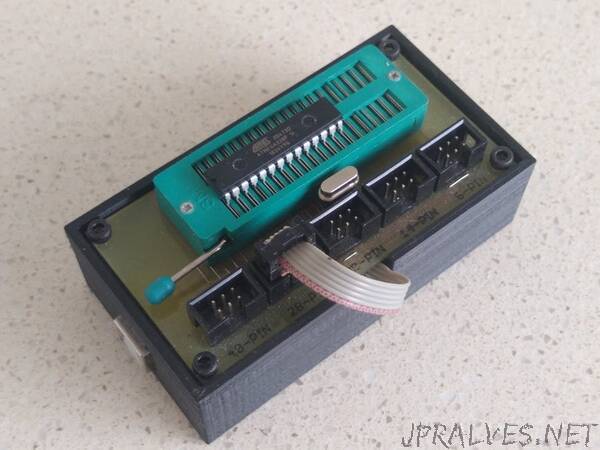
“A programmer designed for easy programming of ATtiny13, ATtinyx5 series ATtinyx4 series, ATtiny2313, ATmega8 series, ATmega328, ATmega8515
Amtel AVR Microcontrollers come in a number of variants. The one most Arduino users know is the 28 pin ATmega328 variant. However AVR chips come in 8-Pin, 14-Pin, 20-Pin and 40-Pin packages as well. The less pins on a chip mean less IO ports. The Digispark board which is an Arduino variant uses a ATtiny85 microcontroller and has only 5 IO pins.
Arduino boards (eg Uno, Mega, Digispark) load software from the Arduino IDE via the USB port. This is only possible because the AVR Microcontroller on the board has already been programmed with a special piece of software called a bootloader. However when you purchase a new AVR Microcontroller, it will be blank and you cannot use the Arduino IDE to program sketches for it.
To program a blank AVR microcontroller, you need a special board such as the USBtinyISP programmer. The USBtinyISP allows you to download the software from your PC via a USB cable and program the chip. On the PC side, you run a program called Avrdude.exe. AVR Microcontrollers are programmed using 6 pins. Unfortunately, owing to the different IC packages, the pins vary. You can use a breadboard to hookup the output of the USBtinyISP to the AVR Microcontroller you want to program. This however quickly becomes a pain. So this build allows you to easily program most AVR DIL packages. It contains a single zero insertion force (ZIF) socket and five 6 pin sockets wired for most variants of the microcontroller.
Version 2
A problem that I have found with AVR microcontrollers (particularly the ATmega328) is that they cannot be programmed without a clock of some kind. If you burn the fuses such that the microprocessor uses an external 16MHz crystal for the clock, you can no longer program it without having that 16MHz crystal and associated capacitors connected to the oscillator pins. My first version of this AVR ISP programmer didn’t support a crystal so every time I added a UNO bootloader, the fuses were set to use a 16MHz external crystal and I could no longer program it using this programmer unless I reset the fuses back to their default using a high voltage programmer such as the ATMega Fuse Doctor. So this new version incorporates a plug in crystal for an external oscillator. The only caveat is that you will need to remove it when programming 40pin AVR microcontrollers. All other variants are fine even if a crystal oscillator is not required.”
